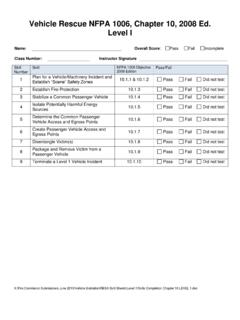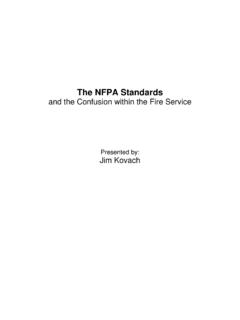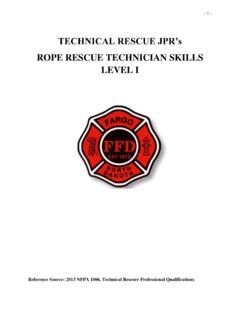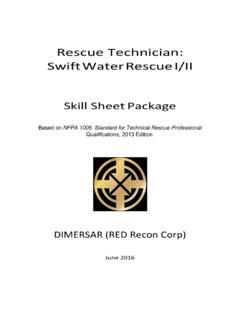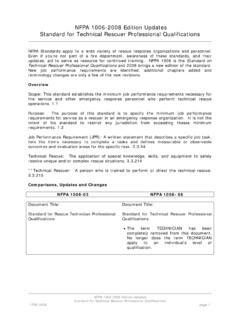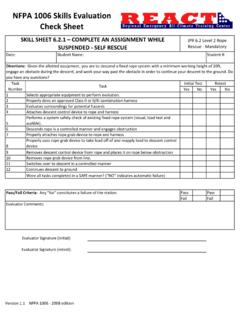Transcription of RIFA Rope Ops - RI Firefighter Instructors Association
1 Technical Rescuer rope rescue technician : Level I nfpa 1006 - Pro Board Course Rhode Island Fire AcademyRhode Island Fire AcademyRHODE ISLAND FIRE ACADEMY - OFFICIAL USE ONLYT echnical Rescue StandardsNFPA 1983 Standard on Life Safety rope and Equipment for Emergency Services 2012 ed. nfpa 1670 Standard on Operations and Training for Technical Search and Rescue Incidents 2014 ed. nfpa 1006 Standard on Technical Rescuer Professional Qualifications 2013 ISLAND FIRE ACADEMY - OFFICIAL USE ONLYNFPA 1983 2012 edition Chapter 4 Certification Chapter 5 Labeling and information Chapter 6 Design and construction requirements Chapter 7 Performance requirements Chapter 8 Test methods3 RHODE ISLAND FIRE ACADEMY - OFFICIAL USE ONLYNFPA 1670 - Awareness (1) Awareness Level This level represents the minimum capability of organizations that provide response to technical search and rescue incidents4 RHODE ISLAND FIRE ACADEMY - OFFICIAL USE ONLYNFPA 1670 - (2)
2 Operations Level This level represents the capability of organizations to respond to technical search and rescue incidents and to identify hazards, use equipment, and apply limited techniques specified in this standard to support and participate in technical search and rescue incidents5 RHODE ISLAND FIRE ACADEMY - OFFICIAL USE ONLYNFPA 1670 - (3) - technician Level This level represents the capability of organizations to respond to technical search and rescue incidents, and to identify hazards, use equipment, and apply advanced techniques specified in this standard necessary to coordinate, perform and supervise technical search and rescue incidents6 RHODE ISLAND FIRE ACADEMY - OFFICIAL USE ONLY7 nfpa 1006 (2013 ed.)
3 Chapter 5 Job Performance Requirements General Requirements Site Operations Victim Management MaintenanceRHODE ISLAND FIRE ACADEMY - OFFICIAL USE ONLY8 nfpa 1006 (2013 ed.) Ropes/Rigging Tie knots Single point anchors Place edge protection Simple mechanical advantage Direct the operation of a simple MA in low angle Litter attendant in low angle Construct a lowering system Direct a lowering operation in low angle Construct and operate a belay system Belay a falling load in high angle Perform a system safety checkRHODE ISLAND FIRE ACADEMY - OFFICIAL USE ONLY9 nfpa 1006 (2013 ed.) Chapter 6 rope Rescue Level I General requirements Direct a team in the operation of a simple MA system in high angle environment Direct a lowering operation in a high angle environment Construct a multiple-point anchor system Construct a compound rope mechanical advantage system Construct a fixed rope system Direct the operation of a compound rope mechanical advantage system in a high-angle Ascend a fixed rope in a high-angle environment Descend a fixed rope in a high-angle environmentRHODE ISLAND FIRE ACADEMY - OFFICIAL USE ONLY10 Types of RescueROPE AS A TOOL FOR RESCUE Belay or Safety Line High Angle Low Angle or Slope Evacuation Confined
4 Space Trench rescue Water/ice rescue Search an area (ex. Wilderness search)RHODE ISLAND FIRE ACADEMY - OFFICIAL USE ONLYD efinitions Low angle rescue when more than half of the weight of the rescuer, equipment, and/or patient is supported by the ground (floor, beam, structure, etc.) High angle rescue when more than half of the weight of the rescuer, equipment, and/or patient is supported by the rope ISLAND FIRE ACADEMY - OFFICIAL USE ONLYD efinitions Vertical rescue when the movement is at right angles to the horizon. All the weight of the rescuer, equipment, and/or patient is supported by the rope system. Slope rescue when there is continual contact with the ground, usually low angle rescue but could include some high ISLAND FIRE ACADEMY - OFFICIAL USE ONLYSITUATIONS THAT MAY REQUIRE rope RESCUE TECHNIQUES Areas inaccessible to ladder trucks, or height greater than that of a ladder truck s aerial device.
5 The need to raise a person from an excavation, trench, construction site, or other rescue scenes involving movement of people in areas involving significant obstacle negotiation13 RHODE ISLAND FIRE ACADEMY - OFFICIAL USE ONLY14 Size Up Distinction between rescue and recovery Scope and Magnitude Additional Resources Location and Number of Victims Risk Benefit AnalysisHazards- utilities, mechanical, hazmat Access to Scene Environmental Factors Separation, isolation, interviewing, security of witnessesRHODE ISLAND FIRE ACADEMY - OFFICIAL USE ONLY15 Rescue vs. Recovery Based on Risk/Benefit Analysis Duration of the operations Mechanism of Injury Environmental conditions Victim accessRHODE ISLAND FIRE ACADEMY - OFFICIAL USE ONLY16 Risk vs.
6 Benefit AnalysisFrequencyRiskHigh Frequency High Risk Emergency Vehicle OperationsHigh Frequency Low Risk Medical callsLow Frequency Low Risk Lock OutsLow Frequency High Risk Technical RescueRHODE ISLAND FIRE ACADEMY - OFFICIAL USE ONLY17 Identify Needed Support Resources Equipment Cache Scene lighting Environmental concerns Personnel rehabRHODE ISLAND FIRE ACADEMY - OFFICIAL USE ONLY18 Managing Incidents Hazards Scene control barriers PPE Specialized equipment and resourcesRHODE ISLAND FIRE ACADEMY - OFFICIAL USE ONLY19 Technical Rescue PositionsRHODE ISLAND FIRE ACADEMY - OFFICIAL USE ONLY20 Conducting a SearchSearch specific PPE Ex.
7 Hearing protection, fall protection, PFD Pertinent search equipment Ex. GPS, helicopters, ATV s Victim information Age, LSP, Number of victims, Accountability Personnel assignments match their expertiseRHODE ISLAND FIRE ACADEMY - OFFICIAL USE ONLY21 Helicopter 100 X 100 Landing Zone Slope of ground & type of ground Obstructions/Hazards Trees, wires, light poles, and antennas. Hazardous Materials Crowds CommunicationGROUND SUPPORT OPERATIONS RHODE ISLAND FIRE ACADEMY - OFFICIAL USE ONLY22 Termination of OperationsMost Dangerous Point Breaking down equipment. Edge tethers left in place. Safety precautions left in Demobilization Plan Releasing Companies / Teams Documentation Consider CISDRHODE ISLAND FIRE ACADEMY - OFFICIAL USE ONLY23 Time Constraints Is EMS with you?
8 Do you have Firefighter Paramedics? Consider - Suspension Trauma Still dealing with the Golden HourRHODE ISLAND FIRE ACADEMY - OFFICIAL USE ONLY24 EMS Access - given tool kits, personal protective equipment and other equipment designed to allow for physical approach to the Assess and Stabilize given personal protective equipment to include protection from airborne and blood borne pathogens and a basic first aid priorities are established. RHODE ISLAND FIRE ACADEMY - OFFICIAL USE ONLY25 EMS Triage given triage tags and local protocol, so that rescue versus recovery factors are Package an ill or injured victim, given basic first aid kit and other specialized or injuries are managed, and potential for further injury is minimized.
9 RHODE ISLAND FIRE ACADEMY - OFFICIAL USE ONLY26 EMS Transfer to EMS, given local medical protocols, so all pertinent information is passed from rescuer to EMS, and the victim can be transported to a medical care facility RHODE ISLAND FIRE ACADEMY - OFFICIAL USE ONLY27 Personal Protective Equipment Helmet Gloves Eye Protection Ear Protection For both Rescuer and Victim Footwear RHODE ISLAND FIRE ACADEMY - OFFICIAL USE ONLY28 Inspection and Maintenance Personal Protective Equipment (Including respiratory equipment) Clean Inspection Maintenance Sanitization Follow manufacturer recommendationsRHODE ISLAND FIRE ACADEMY - OFFICIAL USE ONLY29 Inspection and Maintenance Rescue Equipment Clean Wash or dry equipment Proper inspection after each use (Identify wear and damage)
10 Log equipment use Record time and date of usage Replace equipment when needed Proper disposal methodsRHODE ISLAND FIRE ACADEMY - OFFICIAL USE ONLY30 rope Inspection and MaintenanceDO NOT Step on the rope Drag rope on ground Leave rope under tension Smoke around ropes Store a rope in a poorly vented area Store in direct sunlight Expose a rope to high temperature Run nylon over nylon Subject rope to chemicals,oils, acids, etc Use life safety rope for towing Cause undo abrasion to rope Shock load the ropeDO: Inspect a rope for damage Clean a rope after each use Use edge protection Bag rope , ready for use Remove knot as soon as possible Keep rope log Treat equipment with respectRHODE ISLAND FIRE ACADEMY - OFFICIAL USE ONLY31 AnchorsAnchor Point A single, structural component used either alone or in combination with other components to create an anchor system capable of sustaining the actual and potential load on the rope rescue systemRHODE ISLAND FIRE ACADEMY - OFFICIAL USE ONLY32 Single Point Anchors Solid Bomb proof Critical angle (degrees)

